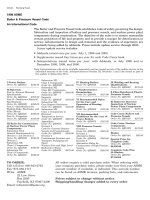Process Engineering Equipment Handbook 2009 Part 15 doc
Bạn đang xem bản rút gọn của tài liệu. Xem và tải ngay bản đầy đủ của tài liệu tại đây (2.4 MB, 80 trang )
Pumps P-233
open to the atmosphere or the absolute pressure in the closed tank or condenser
from which the pump takes liquid. In a deaerating heater, it is normally the
saturated pressure at the existing water temperature. H
z
is the height in feet of the
fluid surface above or below the pump centerline. If above, it is considered to be
plus since the suction head is then increased; if below, it is minus. H
vp
is the head
corresponding to the vapor pressure at the existing temperature of the liquid. H
f
is
the head lost because of friction and turbulence between the surface of the liquid
and the pump suction flange.
In designing a pump installation and purchasing a pump, there are two types
of NPSH to be considered. One is the available NPSH of the system, and the other
is the required NPSH of the pump to be placed in the system. The former is
determined by the plant designer and is based upon the pump location, fluid
temperature, etc., while the latter is based upon suppression pump tests of the
manufacturer. To secure satisfactory operating conditions, the available NPSH
must be greater than the required NPSH. In higher-energy pumps such as boiler-
feed pumps, values of NPSHA should be 1.5 to 2.0 times larger than NPSHR (as
normally measured with a 3 percent drop in head).
The calculation of available NPSH will be illustrated by two examples. The head
corresponding to a given pressure is given by the equation H
p
= 2.31 p/sg, where
p is the pressure in pounds per square inch and sg the specific gravity of the
liquid.
Assume that water at 80°F is to be pumped from a sump. The unit is located at
an altitude of 800 ft above sea level, and the suction lift (from water surface to pump
centerline) is 7 ft. The pipe losses amount to 1 ft head. What is the available NPSH?
The atmospheric pressure at an altitude of 800 ft is 14.27 psia. The specific
gravity of the water at 80°F is 0.9984, and the vapor pressure is 0.5069 psia.
Determine the available NPSH of a condensate pump drawing water from a
condenser in which a 28-in vacuum, referred to a 30-in barometer, is maintained.
The friction and turbulence head loss in the piping is estimated to be 2 ft. The
minimum height of water in the condenser above the pump centerline is 5 ft.
The absolute pressure in the condenser is 30 - 28 = 2 inHg, or 0.982 lb/in
2
. The
corresponding specific gravity is 0.9945.
A third example is that of a deaerating heater having a water level 180 ft above
the pump centerline. The water temperature is 350°F. The pipe friction loss is
HHH H
pzvp
f
=+- -= +- -=228 5 228 2 3 NPSH ft
HH
f
z
==15ft ft
HH
p
pvp
== =
¥
=
2 31 2 31 0 982
0 9945
228
.
.
sg
ft
HHH H
pzvp
f
=+- -= -=32 97 7 1 17 1 23 80 .NPSH ft
H
f
= 1ft
H
p
vp
==
¥
=
2 31 2 31 0 5069
0 9984
117
.
.
sg
ft
H
z
=-
()
7 ft negative since it is a lift
H
p
p
==
¥
=
2 31 2 31 14 27
0 9984
32 97
.
.
sg
ft
12 ft. Since the water in the deareator is in a saturated condition, this absolute
pressure on the surface liquid equals the vapor pressure at 350°F. Then
The required NPSH must be determined in most cases by means of suppression
tests. The Hydraulic Institute has prepared a series of diagrams to estimate this
required head (see Figs. P-243 to P-246 inclusive). These diagrams are not to be
considered as the highest values that can be obtained by careful design, but they
may be used for estimating as they represent average results of good present-day
practice.
The use of the diagrams is simple and may be illustrated by an example. A double-
suction pump operating at 3600 rpm delivers 1000 gal/min against a total head of
200 ft. What should the minimum NPSH be for satisfactory operation? The specific
speed as found from Fig. P-234 is 2200. By referring to Fig. P-243, the point
corresponding to this specific speed for double-suction pumps and a total dynamic
head of 200 ft gives a 12-ft suction lift as the safe maximum. If the same conditions
NPSH
ft
=+- -
=
¥
+-
¥
-=
HHH H
pzvp
f
2 31 134 6
0 892
180
2 31 134 6
0 892
12 168
.
.
P-234 Pumps
FIG. P-243 Upper limits of specific speeds: double-suction pumps handling clear water at 85°F at
sea level. (Source: Hydraulic Institute.)
Pumps P-235
were applied to a single-suction pump with the shaft through the eye of the impeller,
the safe minimum suction condition would require at least a 1 ft positive head (i.e.,
the suction head would have to be at least +1 ft rather than -12 ft; hence, the
required NPSH would be 35 ft instead of 22 ft).
These curves are based upon handling clear water at 85°F and sea-level
barometric pressure. If the water temperature is higher, the difference in head
corresponding to the difference in vapor pressures between 85°F and the
temperature of the water pumped should be subtracted from the suction lift or
added to the suction head. Also, if the unit is to be located above sea level, the
difference in head corresponding to the difference in atmospheric pressures should
be subtracted from the suction lift or added to the suction head.
Thus, in the above example, if the water temperature is 140°F and the plant is
located at an altitude of 2000 ft, the correction for vapor pressure will be 2.889 -
0.596 = 2.293 lb/in
2
, and the correction for altitude will be 14.69 - 13.66 = 1.03 lb/in
2
.
The corresponding head change will be 2.31 (2.293 + 1.03)/0.9850 = 7.8 ft. For
the double-suction pump the maximum suction lift would be 12.0 - 7.8 = 4.2 ft,
and for the single-suction pump the positive suction head would have to be 1.0 +
7.8 = 8.8 ft.
FIG. P-244 Upper limits of specific speeds: single-suction shaft through eye pumps handling clear
water at 85°F at sea level. (Source: Hydraulic Institute.)
A series of diagrams (Figs. P-247 through P-249) have been prepared by the
Hydraulic Institute to determine NPSH on the basis of the flow, operating speed,
and discharge pressure for hot-water and condensate pumps. They may also be used
to find the maximum permissible flow for a given available NPSH.
Hot water. Two curves, Figs. P-247 and P-248, have been prepared for pumps
handling hot water at temperatures of 212°F and above. These curves show the
recommended minimum NPSH in feet for different design capacities and speeds.
Figure P-247 applies to single-suction pumps and Fig. P-248 to double-suction
pumps. These curves serve as guides in determining the NPSH for hot-water pumps
and do not necessarily represent absolute minimum values.
Net positive suction head for condensate pumps. Figure P-249 indicates NPSH for
condensate pumps with the shaft passing through the eye of the impeller. It applies
to pumps having a maximum of three stages, the lower scale representing single-
suction pumps and the upper scale double-suction pumps or pumps with a double-
suction first-stage impeller.
For single-suction overhung impellers the curve may be used by dividing the specified
capacity, if 400 gal/min or less, by 1.2, and if greater than 400 gal/min, by 1.15.
P-236 Pumps
FIG. P-245 Upper limits of specific speeds: single-suction overhung impeller pumps handling clear
water at 85°F at sea level. (Source: Hydraulic Institute.)
Pumps P-237
The curve may be used for capacities and speeds other than shown by the relation
that, for a definite NPSH, the product of rpm ¥÷gal/
——
—
min remains constant.
Minimum flow-through pump. The difference between the power put into a
centrifugal pump and the useful power performed by the pump, or the difference
between the brake and water horsepowers, is converted into heat, most of which
appears as increased temperature of the water. The bhp curve of a pump rated at
500 gal/min against a 2600-ft head and the corresponding water-horsepower curve
are shown in Fig. P-250. If we neglect bearing losses, which are minor, the difference
between these curves at any capacity represents the horsepower absorbed by the
water in the form of heat. Multiplying these differences by 42.4 gives the Btu
generated in the pump per minute. Dividing these values by the flow in pounds
per minute gives the temperature rise at each capacity. This curve is plotted in
Fig. P-250.
This temperature rise is generally not important in single-stage pumps,
particularly if they are handling cold water, but for pumps handling hot liquids,
such as boiler-feed pumps, it may become a serious matter. Then the resulting rapid
temperature rise may cause the internal rotating parts to expand more rapidly than
the heavier encircling parts so that severe rubbing may occur, or the impeller may even
FIG. P-246 Upper limits of specific speeds: single-suction mixed- and axial-flow pumps handling
clear water at 85°F at sea level. (Source: Hydraulic Institute.)
become loose on the shaft. Also the temperature of the water may rise to a point at
which the water flashes into steam, causing the pump to become vapor bound.
The temperature rise in a pump may be calculated from the formula
where Dt = temperature rise, °F
h= overall pump efficiency, expressed as a decimal
c = specific heat of fluid being pumped (equals 1.0 for water)
H = total head of pump, ft
Dt
H
c
=
-
()
1
778
h
h
P-238 Pumps
FIG. P-247 Net positive suction head for centrifugal hot-water pumps, single suction. (Source:
Hydraulic Institute.)
FIG. P-248 Net positive suction head for centrifugal hot-water pumps, double suction, first stage.
(Source: Hydraulic Institute.)
Pumps P-239
FIG. P-249 Capacity and speed limitations for condensate pumps with the shaft through the eye of
the impeller. (Source: Hydraulic Institute.)
FIG. P-250 Pump characteristics. (Source: Demag Delaval.)
The allowable temperature rise of the water before it flashes into steam depends
upon the suction conditions, or NPSH, of the pump. NPSH is the net head above
the vapor pressure corresponding to the temperature of the liquid handled. As
outlined in the subsection “Net Positive Suction Head,” every installation has two
types of NPSH: that available in the installation and that required by the pump.
The maximum allowable vapor pressure at the pump inlet is found by converting
the available NPSH into pounds per square inch and adding this to the vapor
pressure corresponding to the temperature of the liquid being handled. This
pressure is the vapor pressure corresponding to the temperature to which the liquid
may be raised before it will flash into vapor.
After the allowable temperature rise has been established, an approximate
minimum safe continuous-flow efficiency can be obtained by rewriting the previous
equation in the form
where H
so
= heat at no flow, or shutoff head
c = specific heat of liquid
The flow corresponding to this efficiency is found on the pump-performance curves.
In boiler-feed pumps having single-suction impellers, all facing in the same
direction, a leak-off balancing arrangement is used to compensate hydraulic thrust.
If the balancing leak-off flow is returned to the suction of the pump, flashing can
occur at extremely low rates of delivery. Therefore, the balancing flow is frequently
piped to an open heater in the feed system of the pump, where, by flashing, the
temperature of the water will be reduced to that corresponding to the pressure and
there should be no valve of any kind between the junction of the balancing
connection and the heater. Many installations do pipe the balance flow to the pump
suction line.
With the advent of the larger, higher-energy boiler-feed pumps of the 1960s and
1970s, it became apparent that the higher vibration and pressure pulsations
occurring at partial capacities would affect the minimum-flow setting. Consequently,
minimum-flow values of 25 percent of the flow at best efficiency became commonplace,
with higher levels in special cases.
Recirculation connection. The minimum flow through a pump is directed through a
recirculation line from a discharge-line connection to the suction source. This line
has a recirculation orifice designed to pass the required minimum flow or has a
modulating-pressure breakdown valve.
The recirculation connection is in the pump discharge line between the discharge
nozzle and the check valve. All valves in the recirculation line must be open
whenever the pump is operating under any of the following conditions:
1. Low flows
2. Starting pump
3. Stopping pump
The valves should be opened or closed either manually or by automatic controls.
When automatic controls are used, they should be checked at initial starting and
occasionally thereafter during starting procedures.
Figure P-251 shows a diagram of the piping arrangement.
h=
()
+
H
tc H
so
so
778 D
P-240 Pumps
Pumps P-241
Materials for pumping various liquids. The materials used for pumps must be suitable
for the liquids handled to prevent excessive corrosion. The Hydraulic Institute
Standards give the materials to be used for the more common liquids and should
be consulted for selecting the applicable material combination.
From the standpoint of materials, pumps may be divided into three basic types:
standard fitted (combination of iron and bronze), all iron, and all bronze. Other
materials, including corrosion-resisting steels, are listed in the subject standards.
Table P-28 gives a summary of the various materials used for centrifugal pumps.
If the liquid to be handled is an electrolyte, the use of dissimilar metals in close
combination, especially those that are widely separated in the galvanic series,
should be avoided insofar as possible. The use of bronze and iron in the same pump
handling seawater will greatly accelerate the corrosion of the cast iron parts.
A table of the galvanic series is given in Table P-29.
Pump application
General. As outlined in the subsection “Classification,” there are on the market a
multitude of centrifugal-pump types. Some of the basic types will be mentioned
here.
Single-stage, double-suction pump. See Fig. P-252. This type of centrifugal pump
is the most common one and is used for general service in industrial and municipal
plants. In the larger sizes, the use of these pumps is almost universal for
municipal-water distribution, and pumps of this type are in service in practically
every major city of the United States. For heads up to 300 ft or higher, single-stage
pumps are used, while for higher heads two or more units are arranged in series.
Figure P-253 shows an installation of two motor-driven units arranged in series.
FIG.
P-251 Recirculating connections for boiler-feed service. (Source: Demag Delaval.)
Boiler-feed pumps. For industrial use, multistage split-case pumps having two to
six or more stages are employed. See Figs. P-254 and P-255.
For utility service the pressures are now generally in the range of 2000 to
5000 lb/in
2
, and barrel-type multistage units are used. See Fig. P-256.
Hydraulic-pressure pumps. Pumps similar to those used in boiler-feed service are
employed for this application.
P-242 Pumps
TABLE
P-28 Summary of Material Selections and National Society Standards
Designations*
ASTM
†
ACI AISI Remarks
A48, Classes 20, 25, 30, 35, 40, and 50 . . . . . . Gray iron—six grades
A339, A395, and A396 . . . . . . Nodular cast iron—five grades
B143, 1B and 2A; B144, 3A; B145, 4A . . . . . . Tin bronze—six grades (includes
two grades not covered by
ASTM Specifications)
A216—WCB . . . 1,030 Carbon steel
A217—C5 . . . 501 5% chromium steel
A296—CA15 CA15 410 13% chromium steel
A296—CB30 CB30 . . . 20% chromium steel
A296—CC50 CC50 446 28% chromium steel
A296—CF-8 CF-8 304 18-8 austenitic steel
A296—CF-8M CF-8M 316 18-8 molybdenum austenitic steel
A296—60T CN-7M . . . A series of highly alloyed steels
normally used where the
corrosive conditions are severe
. . . . . . . . . A series of nickel-base alloys
. . . . . . . . . High-silicon cast iron
. . . . . . . . . Austenitic cast iron
A439 . . . . . . Nodular austenitic cast iron
. . . . . . . . . Nickel-copper alloy
. . . . . . . . . Nickel
*Reprinted from Hydraulic Institute Standards, 11th ed., Hydraulic Institute, New York, 1965.
†ASTM = American Society for Testing and Materials; ACI = Alloy Casting Institute; AISI = American Iron
and Steel Institute.
FIG. P-252 Cross-section of a double-suction pump. (Source: Demag Delaval.)
Pumps P-243
Condensate pumps. Special pumps, which may be either single-suction or double-
suction, are used for this service; they are designed to operate at low submergence.
Figure P-257 shows a three-stage single-suction vertical unit of this type.
Nonclogging pumps. Pumps for this service are designed to ensure maximum
freedom from clogging. They are usually of the single-suction type. For the larger
sizes, mixed-flow pumps are used, as shown in Fig. P-258.
Design details. The general arrangement of several basic centrifugal-pump types
has been covered under “Pump Application.” See Figs. P-252 through P-259. Some
special design features are discussed below.
Axial balance. The impeller of a single-suction centrifugal pump has an unbalanced
hydraulic thrust directed axially toward the suction. This is due to the difference
in pressure of the fluid that has passed through the impeller and of the fluid on the
TABLE
P-29 Galvanic Series of Metals and Alloys*
Corroded End (Anodic, or Least Noble)
Magnesium
Magnesium alloys
Zinc
Aluminum 2S
Cadmium
Aluminum 17ST
Steel or iron
Cast iron
Chromium stainless steel, 400 series (active)
Austenitic nickel or nickel-copper cast-iron alloy
18-8 chromium-nickel stainless steel, type 304 (active)
18-8-3 chromium-nickel-molybdenum stainless steel, type 316 (active)
Lead-tin solders
Lead
Tin
Nickel (active)
Nickel-base alloy (active)
Nickel-molybdenum-chromium-iron alloy (active)
Brasses
Copper
Bronzes
Copper-nickel alloy
Nickel-copper alloy
Silver solder
Nickel (passive)
Nickel-base alloy (passive)
Chromium stainless steel, 400 series (passive)
18-8 chromium-nickel stainless steel, type 304 (passive)
18-8-3 chromium-nickel-molybdenum stainless steel, type 316 (passive)
Nickel-molybdenum-chromium-iron alloy (passive)
Silver
Graphite
Gold
Platinum
Protected End (Cathodic, or Most Noble)
* Reprinted from Hydraulic Institute Standards, 11th ed., Hydraulic Institute, New York, 1965.
P-244 Pumps
FIG. P-253 Installation of two double-suction pumps arranged in series, motor driven. (Source:
Demag Delaval.)
FIG.
P-254 Cutaway view of a two-stage pump. (Source: Demag Delaval.)
FIG. P-255 Motor-driven multistage pump. (Source: Demag Delaval.)
Pumps P-245
suction side. Several methods have been devised to counteract this force and avoid
the use of large thrust bearings.
If a double-suction impeller (Fig. P-252) is used, the pressures are symmetrical
about the centerline and no unbalanced thrust should exist.
On multistage units single-suction impellers placed back to back, as illustrated
in Fig. P-254, may be employed. The axial thrust created in one impeller is thus
balanced by the corresponding thrust in the other, any remaining thrust being
taken by a small thrust bearing.
FIG. P-256 Double-case boiler-feedwater pump. (Source: Demag Delaval.)
FIG. P-257 Typical assembly of a three-stage condensate pump. (Source: Demag Delaval.)
P-246 Pumps
FIG. P-259 Nuclear feedwater pump. (Source: Demag Delaval.)
FIG. P-258 Cutaway view of a mixed-flow pump. (Source: Demag Delaval.)
Pumps P-247
An alternative method of automatically providing a balanced thrust arrangement
in boiler-feed pumps is shown in Figs. P-259 and P-260. As shown in Fig. P-260,
water at essentially discharge pressure enters the clearance between the rotating
and stationary drums at A. The water follows a path through the first fixed orifice
(A to B), through the variable orifice (B to C), and then through the second fixed
orifice (C to D). Chamber D is connected by a pipe to the suction source.
Should a condition of increased impeller thrust toward suction occur, the rotor
tends to move toward suction, closing the variable orifice between the disk faces (B
to C). By thus reducing the balance flow, the pressure drop between A and B
decreases. The resulting greater pressure at B creates an increased thrust in the
outboard direction, thereby providing self-compensation for the increased impeller
thrust.
A similar type of self-compensating balance occurs if the impeller thrust toward
suction should decrease. The rotor is free to move axially and hence permits the
variable gap at the disk faces to match the requirements for hydraulic balance.
Still another method of balancing in-line multistage boiler-feed pumps is the use
of a fixed-diameter balance drum similar to the A-to-B portion of Fig. P-260. This
method also is reliable, but it generally requires a larger thrust bearing.
Double-volute pumps. The pressure within the casing of any pump develops radial
forces when operating at capacities other than normal. The result of these radial
forces in single-volute casings is shaft deflection. This is especially true if the pump
operates for extended periods at other than design capacity, since imbalance from
the radial forces then becomes greater. For such applications, double-volute pumps
are used (Fig. P-261).
In the double-volute casing, the water leaving the impeller is collected in two
similar volutes, the tongues of which are set 180° apart. The two volutes merge into
a common outlet to form the discharge of the pump. Hydraulic forces (indicated by
FIG. P-260 Axial balance-drum and disk combination. (Source: Demag Delaval.)
arrows) produced by the pressure in one volute are balanced by equal forces
produced by the pressure in the other volute. Thus, radial thrust is counterbalanced
and for all practical purposes is eliminated.
The double-volute pumps provide insurance against shaft deflection and savings
in repairs and shutdown time.
Centrifugal-pump stuffing boxes. Stuffing boxes are located on pumps where the
rotating shaft enters the pump case. They contain packing or mechanical seals that
control the leakage of fluid from within or of air from without.
Stuffing boxes. A typical stuffing box using packing, as shown in Fig. P-262, has a
plain throat bushing, seal ring, and packing gland. Figure P-263 shows a water-
cooled stuffing box with quench glands and breakdown bushing. Stuffing boxes may
have various combinations of the features shown in Figs. P-262 and P-263,
depending upon operating conditions.
The innermost packing ring is usually placed against a solid removable throat
bushing. The plain bushing of Fig. P-262 is used for suction lifts and moderate
pressures. Higher pressures require the breakdown bushing of Fig. P-263. It
P-248 Pumps
FIG. P-261 Double-volute pump. (Source: Demag Delaval.)
FIG. P-262 (1) Packing gland; (2) packing; (3) seal ring; (4) pump cover; (5) shaft sleeve; (6) throat
bushing; (7) shaft; (8) pump case. (Source: Demag Delaval.)
Pumps P-249
relieves the pressure on the packing, reduces mechanical losses, and lessens wear
on the shaft sleeve.
Seal rings are placed between rows of packing (see Fig. P-262). They provide a
space surrounding the shaft for the sealing liquid. This forms a seal which, when
a vacuum exists in the suction chamber of the pump, prevents air from entering.
In addition, it ensures lubrication for the packing. The liquid comes from either an
outside source or a high-pressure portion of the pump.
Packing is held in the stuffing box by packing glands. These are usually split,
making it possible to remove them without taking the pump apart. Quench glands
are used when the liquid being pumped exceeds a safe margin on its vapor pressure.
Glands are pulled into place by gland bolts. Frequently these are swing bolts,
making disassembly easier.
Renewable shaft sleeves usually protect the shaft where it passes through the
stuffing boxes. Bronze is most commonly used for cold-water applications. High
suction pressures, elevated temperatures, dirty water, and many liquids call for
special materials.
The packing-ring cross-section is square. A good grade of braided asbestos
impregnated with graphite is most commonly used, especially for water service.
This often comes in a continuous coil that is cut into proper lengths for making
rings. The cut should preferably be on a diagonal, with a slight gap to allow for
expansion when put in place. Gaps for adjacent rings should be staggered. Metallic
packing rings are required for some service, and one of the recommended
combinations for high-pressure boiler-feed service is shown in Fig. P-263. These
packings are usually purchased in molded sets from the packing manufacturer. Also
note the special water-jacketed stuffing box in Fig. P-263.
Packing does its sealing along the shaft. It is pliable in order to form itself around
the shaft. Cutting down the leakage by tightening up on the packing increases
friction, resulting in more power required and increased wear on the shaft or shaft
sleeve.
Packing requires a certain amount of leakage to keep it lubricated. Certain
applications, such as corrosive acids and inflammable, gritty, or contaminated
FIG. P-263 (1) Packing nut; (2) packing ring; (3) quench gland; (4) packing box; (5) gasket; (6) shaft
sleeve; (7) shaft; (8) pump cover; (9) breakdown bushing; (10) pump case; H = metallic packing; S =
plastic packing. (Source: Demag Delaval.)
liquids, cannot allow leakage. Mechanical seals are now being used for these
applications as well as for high-pressure water seals.
Mechanical seals. Mechanical seals consist of a stationary and a rotating member
with some manner of auxiliary seal. The liquid in the stuffing box is prevented from
passing along the shaft by means of the auxiliary seal (an O-ring, bellows, wedge
ring, or other device). The rotating member is forced against the stationary member
by a spring or springs and by pressure in the stuffing box. The liquid tries to leak
through the contacting surfaces and forms a liquid-pressure wedge that prevents
the seal faces from actually making contact during operation.
Three general types of mechanical seals are used: single seal, double seal, and
balanced seal.
A typical single-seal mechanical seal used for most applications is shown in Fig.
P-264. Hydraulic forces on the sealing washer are unbalanced, as shown in Fig. P-
265, limiting the use of single-seal mechanical seals to moderate pressures.
A typical balanced mechanical seal used for high pressures (see Figs. P-266 and
P-267) shows how areas on each side of the sealing washer are adjusted to reduce
unbalanced forces by stepping down the shaft. This keeps the pressure between
sealing surfaces within allowable limits.
A typical double mechanical seal is shown in Fig. P-268. Simply stated, this is
two single seals mounted back to back with space for an isolating liquid between
them. Such seals are used for liquids that have high temperatures or are gritty,
corrosive, volatile, contaminating, etc.
Seals for boiler-feed pumps. Although in the past, the rubbing velocity of the contact
surfaces has been a limitation, these velocities increased in the 1970s to 230 ft/s or
more, and mechanical-seal applications have increased in boiler-feed pumps,
particularly in Europe.
In boiler-feed-pump applications that exceed the limitations of packing or
mechanical seals, serrated bushing seals and multifloating ring seals are generally
used. Examples of the latter two types are shown in Figs. P-269 and P-270,
P-250 Pumps
FIG. P-264 Mechanical seal: (1) packing gland; (2) gasket; (3) stationary seal; (4) rotating seal; (5)
pump cover; (6) throat bushing; (7) shaft; (8) shaft sleeve; (9) pump case. (Source: Demag Delaval.)
Pumps P-251
respectively. In both cases, a cool external water supply—generally condensate—is
injected into the seals. The cold injection water prevents flashing in the seals that
would otherwise occur if the high-temperature water in the pump were permitted
to flow through the seals to atmospheric pressure.
In differential-pressure control systems, a constant differential between seal
injection-water pressure and seal chamber pressure permits some water to enter
FIG.
P-265 Balanced mechanical seal: (1) packing gland; (2) gasket; (3) stationary seal; (4)
rotating seal; (5) pump cover; (6) shaft sleeve; (7) throat bushing; (8) shaft; (9) pump case. (Source:
Demag Delaval.)
FIG. P-266 Balanced mechanical seal: (1) packing gland; (2) gasket; (3) stationary seal; (4) rotating
seal; (5) pump cover; (6) shaft sleeve; (7) throat bushing; (8) shaft; (9) pump case. (Source: Demag
Delaval.)
the seal chamber and the larger portion of the injection water to pass outboard to
an atmospheric drain. This has the advantages of having no out-leakage from the
pump and having only filtered water flowing from the seals.
In temperature-controlled systems, the amount of seal injection water is
regulated by the temperature of the drain water from the seals. One advantage of
P-252 Pumps
FIG. P-267 Double mechanical seal: (1) packing gland; (2) gasket; (3) stationary seal; (4) rotating
seal; (5) pump cover; (6) throat bushing; (7) shaft sleeve; (8) shaft; (9) pump case. (Source: Demag
Delaval.)
FIG. P-268 Double mechanical seal: (1) packing gland; (2) gasket; (3) stationary seal; (4) rotating
seal; (5) pump cover; (6) throat bushing; (7) shaft sleeve; (8) shaft; (9) pump case. (Source: Demag
Delaval.)
Pumps P-253
FIG. P-269 Injection-type serrated bushing seal: (042) capscrew; (204) check nut; (220) housing;
(221) bushing; (223) sleeve; (225) guard; (227) cover; (230) gasket; (237) O-ring; (290) key; (291)
O-ring (metallic). (Source: Demag Delaval.)
FIG. P-270 Injection-type multifloating ring seal: (042) capscrew; (204) check nut; (225) guard; (227)
cover; (228) bolt; (230) gasket; (237) O-ring; (240) housing; (241) seal subassembly; (254) key; (258)
capscrews; (260) sleeve; (261) ring; (290) key; (291) O-ring (metallic). (Source: Demag Delaval.)
this system is that normally no cold water enters the pump since all the seal
injection water flows outward.
Although the examples in Figs. P-269 and P-270 show single cooling-water
injection, other variations having double injection and/or additional bleed-off
connections are used.
Warmup procedure. In starting boiler-feed pumps, the warm-up procedure plays a
vital role. It is important to eliminate temperature gradients within the pump to
reduce rotor distortion prior to startup. These temperature gradients are usually
measured by monitoring case temperatures at locations as determined by the
manufacturer. The highest temperature differential should not exceed 50°F, and the
difference between the inlet temperature and the warmest part of the case should
normally be not more than 50°F.
To obtain minimum temperature gradients, the warm-up water should enter the
case through a warmup connection at the bottom of the case and discharge through
the suction nozzle. A recommended schematic is shown in Fig. P-271, with water
supplied from the bleed-off connection of the operating pump.
Alternative warmup paths may be used, but case temperatures should be the
controlling factors.
Effect of operating temperature on pump efficiency at constant speed.* Variations in
temperature of the fluid pumped cause changes in the specific weight and viscosity,
with resultant changes in the performance of the pump.
Any reduction in specific weight, as caused by an increase in temperature, results
in a directly proportional reduction in Lhp (as covered in the subsection
“Determination of Power Required”) and in input power; so the efficiency is not
changed.
Reduced viscosity will have an influence on efficiency, and for pumps in the lower
range of specific speed, such as high-pressure multistage boiler-feed pumps and
large single-stage hot-water-circulating pumps, reduced viscosity will
1. Increase the internal leakage losses
2. Reduce disk friction losses
3. Reduce hydraulic skin friction or flow losses
P-254 Pumps
* Courtesy of the Hydraulic Institute.
FIG. P-271 Warmup piping. (Source: Demag Delaval.)
Pumps P-255
The net effect of a reduction in viscosity due to higher temperature will depend
on specific speed and on the design details of the pump. When substantiating data
are available and when a high degree of understanding exists between the
manufacturer and the user, consideration may be given to adjusting the
performance data from a cold-water test to hot-water operating conditions on
the basis of the following formula:
where h
t
= efficiency at test temperature, decimal value
h
0
= efficiency at operating temperature, decimal value
v
0
= kinematic viscosity at operating temperature
v
t
= kinematic viscosity at test temperature
n = exponent to be established by manufacturers’ data (probably in the
range of 0.05 to 0.1)
Typical example of adjustment of efficiency for increased temperature. Atest on water at 100°F
resulted in an efficiency of 80 percent. What will be the probable efficiency at 350°F?
Vibration limits of centrifugal pumps
General. Recommendations for upper limits of vibration of centrifugal-pump units
under field-operating conditions are shown in the curves in Figs. P-272 and P-273.
Figure P-272 is for centrifugal pumps handling clean liquids, and Fig. P-273 is for
vertical or horizontal centrifugal nonclog dry-pit pumps.
hh
h
h
h
0
0
0
01
0
0
11
11080
0 00000185
0 0000076
1 0 2 0 868
0 826 82 6
=- -
()
Ê
Ë
ˆ
¯
=- -
()
Ê
Ë
ˆ
¯
=-
()
==
t
t
n
v
v
.
.
.
.
percent
hh
0
0
11=- -
()
Ê
Ë
ˆ
¯
t
t
n
v
v
FIG. P-272 Acceptable field vibration limits for centrifugal pumps handling clean liquids.
Frequency corresponds to revolutions per minute when dynamic unbalance is the cause of
vibration. Vertical pumps: measure vibration at top motor bearing. Horizontal pumps: measure
vibration on bearing housing. (Source: Hydraulic Institute.)
In using these curves, the following conditions apply:
1. Curves are applicable when the pump is operating at rated speed within ±10
percent of rated capacity.
2. Measurements should be made as indicated on the appropriate curve sheet.
3. Piping should be connected so as to avoid strains on the pump.
The curves should be used as a general guide, with recommendations that
vibrations in excess of the curve may require investigation and correction. Often
more important than the actual vibration itself is the change of vibration over a
period of time. Vibrations in excess of the curves may often be tolerated if they show
no increase over considerable periods of time and if there is no other indication of
damage, such as an increase in bearing clearance.
Factors affecting vibration. A number of factors besides physical unbalance of the
rotating parts may cause vibration. Among these are:
1. Resonance between the unit and its foundation or piping or resonance within
the unit due to natural frequency of the pump, the motor frame, the motor-
supporting pedestal, or the foundation. Resonant vibrations may also be caused
by other equipment in operation in the area.
2. Operation at or near a critical speed. The amount of vibration observed
will depend on the degree of unbalance and damping present. Normal design
practice is to avoid a critical speed by approximately 25 percent.
3. Vibrations due to hydraulic disturbances caused by improper design of the
suction piping or sump. Disturbances may also be caused by improperly designed
valves, piping supports, piping, and other components exterior to the pump. Such
vibrations are usually at random frequencies.
P-256 Pumps
FIG. P-273 Acceptable field vibration limits for vertical or horizontal centrifugal nonclog pumps.
Frequency corresponds to revolutions per minute when dynamic unbalance is the cause of
vibration. Vertical pumps: measure vibration at top motor bearing. Horizontal pumps: measure
vibration on bearing housing. (Source: Hydraulic Institute.)









